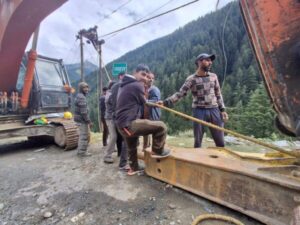Pong Dam’s 50-Year Record Highlights Growing Uncertainty in Water Management

For nearly five decades, the Pong Dam on the Beas River has mirrored the erratic nature of the monsoon.
In some years, the reservoir nearly reached full capacity, triggering floods in the downstream plains. In others, it struggled to fill, exposing vulnerabilities in water security across the region.
The fluctuating water levels at the dam not only reflect the changing behavior of the Beas River but also underline the growing challenges of managing floods, droughts, and livelihoods within the river basin.
Since its commissioning in 1974, the Pong Dam was expected to be a stable lifeline—irrigating fields in Punjab, Haryana, and Rajasthan, and generating electricity for the national grid. In its early years, it largely fulfilled that promise.
On March 23, 1975, the reservoir’s level had plummeted to its lowest at 1,163.8 feet, only to rise dramatically to 1,376.3 feet by September, illustrating the sharp swings that rainfall-dependent systems can experience.
In September 1978, after a heavy monsoon, the dam’s water level peaked at 1,405 feet—the highest recorded. During the 1980s and 1990s, it frequently crossed 1,390 feet, reaching 1,404.23 feet in 1988 and 1,397.49 feet in 1995.
However, this stability has faded. From the early 2000s, peak levels began to decline. By 2007, the highest level was only 1,365.28 feet, and in 2009, it dropped further to 1,339.46 feet. Even average monsoon seasons failed to fill the reservoir, as seen in 2021 when it peaked at just 1,354.56 feet.
Between 2010 and 2022, Pong reached 1,390 feet only once—in 2010 at 1,394.49 feet. Exceptions like 2017 (1,383.6 feet) and 2018 (1,392.55 feet) failed to mask the overall decline.
Recently, the reservoir’s fluctuations have persisted: 1,385.2 feet in 2022, 1,398.68 feet in 2023 after a severe monsoon, and 1,394.51 feet on September 4, 2025.
A Deeper Story
These numbers tell a deeper story—rainfall in the Beas catchment has become irregular, arriving in bursts rather than steady flows. Without reliable storage, sudden floods and sharp inflows occur without warning. Sediment buildup in the reservoir further worsens the crisis.
A study by the Bhakra Beas Management Board’s scientists reveals that Pong has already lost one-fifth of its original capacity due to silt accumulation from the catchment area at an annual rate of 0.25%. This sediment clogs the reservoir, reducing its effectiveness.
The risks are significant. Farmers in Punjab, Haryana, and Rajasthan rely heavily on water from the Pong reservoir for irrigation. When storage is reduced, allocations are cut, forcing farmers to depend on groundwater—which is already dangerously depleted in parts of Punjab, where over 75% of revenue blocks are classified as “over-exploited.”
Hydropower generation is equally affected. The dam’s six turbines require sufficient water levels and flow. As levels drop, electricity production suffers—especially during peak summer demand. Conversely, when the reservoir fills up, emergency water releases flood the Beas valley, damaging downstream farmland and infrastructure while clogging turbines with silt, forcing shutdowns that sometimes last for days.
Immediate Solutions
The dam’s alarming trajectory calls for urgent action. Reforestation, soil conservation, and systematic dredging in the catchment area are essential to restore storage capacity. Improved reservoir management based on accurate rainfall forecasts could help balance flood control with irrigation and power needs.
Lessons for the Future
Pong’s half-century record reflects the contradictions of water management in North India. Once a symbol of hope in the 1970s and 1980s, the dam now represents growing uncertainty caused by climate change, sediment stress, and rising water and power demands.
The lesson is clear: the future requires not only larger reservoirs but also robust ecological management, efficient irrigation systems, and adaptive planning. Without these measures, the region faces the worst of both extremes—parched fields in some years and devastating floods in others.

Continuing the achievement of the journey of effectiveness and credibility of more than 10 years in the career of journalism, as a woman journalist, I am Serving as the founder, promoter and editor of DiaryTimes with the trust and support of all. My credible coverage may not have given a big shape to the numbers, but my journey presents articles that make you aware of the exact and meaningful situations of Himachal’s politics, ground issues related to the public, business, tourism and the difficult geographical conditions of the state and financial awareness. DiaryTimes, full of the experience of my precise editorial expertise, is awakening the flame of credible journalism among all of you, so that the eternal flame of meaningful change can be lit in the life of the people of the state and the atrocities being committed against the people can be brought to the fore, I am motivated for that. If even a small change comes with the power of my journalism and the whole world becomes a witness to that issues, then I will consider myself fortunate.





